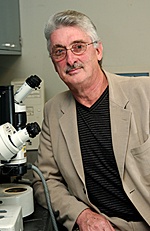Jun 23 2009
Scientists at the University of Delaware say they have developed a new hydrogen storage method -- carbonized chicken feather fibers -- that can hold vast amounts of hydrogen, a promising but difficult to corral fuel source, and do it at a far lower cost than other hydrogen storage systems under consideration.
 Richard Wool
Richard Wool
The research, presented Tuesday, June 23, at the 13th annual Green Chemistry and Engineering Conference being held in College Park, Md., could eventually help overcome some of the hurdles to using hydrogen fuel in cars, trucks and other machinery.
The conference is organized by the American Chemical Society (ACS) Green Chemistry Institute, a nonprofit organization devoted to promoting and advancing the discovery and design of chemical products and processes that eliminate the generation and use of hazardous substances in all aspects of the global chemical enterprise.
“Carbonized chicken feather fibers have the potential to dramatically improve upon existing methods of hydrogen storage and perhaps pave the way for the practical development of a truly hydrogen-based energy economy,” says Richard P. Wool, professor of chemical engineering and director of the University's Affordable Composites from Renewable Resources (ACRES) program.
The research was presented by Erman Senoz, a graduate student in UD's Department of Chemical Engineering.
Chicken feather fibers are mostly composed of keratin, a natural protein that forms strong, hollow tubes. When heated, this protein creates crosslinks, which strengthen its structure, and becomes more porous, increasing its surface area. The net result is carbonized chicken feather fibers, which can absorb as much or perhaps more hydrogen than carbon nanotubes or metal hydrides, two other materials being studied for their hydrogen storage potential, Wool says. Plus, they're cheap.
Using carbonized chicken feathers would only add about $200 to the price of a car, according to Wool. By comparison, making a 20-gallon hydrogen fuel tank that uses carbon nanotubes could cost $5.5 million; one that uses metal hydrides could cost up to $30,000, Wool says.
Hydrogen, the most common element in the universe, has long been touted as a clean and abundant energy alternative to fossil fuels. But its physical characteristics make it very difficult to store and transport - as a pressurized gas it takes up about 40 times as much space as gasoline; as a liquid it needs to be kept at extremely low temperatures.
Wool estimates that it would take a 75-gallon tank to go 300 miles in a car using carbonized chicken feather fibers to store hydrogen. He says his team is working to improve that range.
“The problem with hydrogen as a gas or liquid is its density is too low,” Wool says. “Using currently available technology, if you had a 20-gallon tank and filled it with hydrogen at typical room temperature and pressure, you could drive about a mile. When we started we didn't know how well carbonized chicken feathers would work for hydrogen storage, but we certainly suspected we could do a lot better than that.”
In addition to hydrogen storage, Wool and his colleagues are working on ways to transform chicken feather fibers into a number of other products including hurricane-resistant roofing, lightweight car parts and bio-based computer circuit boards.